Fresh grout looks beautiful. But without proper cleaning and maintenance, it can become stained, mildewed or even cracked. If your grout starts cracking and falling, water can seep behind the wall and cause major damage. Try choosing a grout with a crack-free guarantee. This will help in the long run to prevent additional repairs down the road.
Ways to Clean Stained Grout
If you want to keep your tiles clean, you should include wiping-and-spraying in your daily cleaning routine. Doing so will prevent premature staining and damage. Yes, it can be a bit annoying, but it will save you lots of hard work in the long run.
Here are some simple steps for grout cleaning:
- First, make a paste from two parts bicarbonate of soda to one part water. Then, rub it on the dirty grout using an old toothbrush.
- Next, fill a spray bottle with vinegar. Spray it over the bicarb mix. You will notice that it will start bubbling up into a thick mixture.
- Using your toothbrush to scrub away the grime or a stiff bristle grout brush is a good tool as well.
- After that, rinse it well with warm water.
The following are other ways of grout cleaning you might want to consider doing:
Using a Grout Eraser
Does scrubbing with an old toothbrush fill you with dread? You can try using a grout eraser. Yes, it is more expensive than the bicarb method. But if your grout is super grimy, a grout eraser will save you some excessive scrubbing.
Keep in mind that these sponges wear down fast. So, you will need a few if you have a whole bathroom to clean. You can cut them into a convenient size before wiping them over your grout.
Using a Vinegar Spray
Dirt and mold can cling to limescale. Regular use of a distilled white vinegar spray is a great way of keeping limescale at bay. It also helps disinfect and maintain the shine. You can buy a pre-made spray. But you can also make your own since it is easy and cost-effective.
Grab an old spray bottle and mix up a solution with half water and half vinegar. You can use it to spray down your shower walls and tiles several times a week. Make sure to use white vinegar and not a malt vinegar mix from your condiment cupboard.
Using Hydrogen Peroxide
You can use hydrogen peroxide for moderate stains in the grout. Hydrogen peroxide is available in most drug stores. You can use this product straight or as part of a homemade grout-cleaning paste. The mixture of baking soda and hydrogen peroxide is safe for both sealed and unsealed grout.
Using Mold Removers
You can find specialist cleaners designed to remove mold and help control regrowth. If you plan to use mold removers, make sure to always follow the instructions on the bottle.
Final Thoughts
Cleaning grout begins with good prevention, cleaning up your kitchen spills right away, and using a mild commercial or homemade grout cleaner as well as a grout sealer on a regular basis. Once the grout begins to look dingy or is stained, refer to the steps above.
Finally, be sure to keep the grout maintained and sealed according to your tiling manufacturer’s recommendation. Always avoid harsh scrubbers or cleansers if the tile and grout are prone to damage. Keeping grout clean and sealed on a regular basis beats having to repair, or regrout it.

